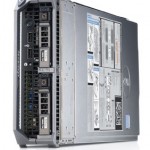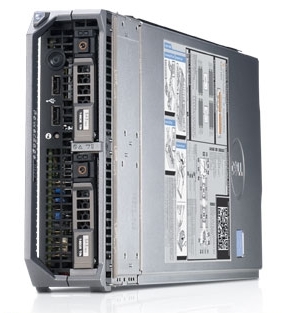The International Data Corporation’s (IDC) released their Worldwide Quarterly Server Tracker today covering Q4 2011. Despite a 7.2% decrease in the worldwide server factory revenue, the blade market continued to experience growth in 4Q11 with factory revenue increasing 8.3% year over year. Other key facts from the IDC press release: Continue reading
Monthly Archives: February 2012
Dell Announces New Blade Server – M620
In anticipation of Intel’s upcoming E5-2600 CPU (aka Sandy Bridge) announcement, Dell officially announced the 12th Generation of PowerEdge servers today. Although the specifics of the 12th Generation, or “12G”, servers have not yet been released, it is very clear there will be a new blade server added to the Dell PowerEdge portfolio: the M620.
While Dell.com announcement site does not have a lot of the details of what’s coming in 12G, The Register has been able to secure some good information on the Dell PowerEdge M620 blade server that I’ll share with you.
- The M620’s size is “half-height”allowing you to put up to 16 inside of the Dell PowerEdge M1000e chassis.
- It will hold up to 2 x Intel Xeon E5 CPUs
- It will hold up to 768GB of RAM (the same as its tower and rack equivalent)
- The M620 has two hot-plug, 2.5-inch drive bays, and can have SSD, SATA disk, or SAS disk drives slid into those two slots.
- The PERC S110 controller with software raid and the PERC H310, H710, and H710P controllers for internal RAID arrays can snap onto this M620 blade.
- The M620 has two SD cards for redundant embedded hypervisors to sit on.
Of course, there are a few other goodies that The Register didn’t mention – so I’ll hold off talking about until the official Intel announcement.
To read the full article from The Register discussing the next generation of Dell PowerEdge server (including the tower and rack models,) go to http://www.theregister.co.uk/2012/02/27/dell_poweredge_12g_server_launch/
Kevin Houston is the founder and Editor-in-Chief of BladesMadeSimple.com. He has over 15 years of experience in the x86 server marketplace. Since 1997 Kevin has worked at several resellers in the Atlanta area, and has a vast array of competitive x86 server knowledge and certifications as well as an in-depth understanding of VMware and Citrix virtualization. Kevin works for Dell as a Server Specialist covering the Global 500 East market.
Where Did Blade Servers Come From?
 As I mentioned yesterday, one of my fellow bloggers, Stephen Foskett, is writing a series on blade servers. His latest post reveals the history of the blade server. Stephen’s article challenged me to do some research of my own – and here’s what I found. Apparently the first “official” patent for a server on blade (patent # 6,411,506 – “High density web server chassis system and method) was awarded in June of 2002 to Christopher G. Hipp and David M. Kirkeby of RLX Technologies. One interesting fact is that U.S. Patents referenced within the document refers to other patents from many leaders of the industry including IBM, Hewlett-Packard, Micron, Hitachi and even Dell.
As I mentioned yesterday, one of my fellow bloggers, Stephen Foskett, is writing a series on blade servers. His latest post reveals the history of the blade server. Stephen’s article challenged me to do some research of my own – and here’s what I found. Apparently the first “official” patent for a server on blade (patent # 6,411,506 – “High density web server chassis system and method) was awarded in June of 2002 to Christopher G. Hipp and David M. Kirkeby of RLX Technologies. One interesting fact is that U.S. Patents referenced within the document refers to other patents from many leaders of the industry including IBM, Hewlett-Packard, Micron, Hitachi and even Dell.
I’ve taken the liberty of downloading the entire patent document for your reference:
High Density Web Server Chassis – Patent 6411506 B1 (1.84Mb, PDF).
If you like technology and are a history buff, I recommend you check out Stephen’s article at http://blog.fosketts.net/2012/02/20/blade-server-history/.
Kevin Houston is the founder and Editor-in-Chief of BladesMadeSimple.com. He has over 15 years of experience in the x86 server marketplace. Since 1997 Kevin has worked at several resellers in the Atlanta area, and has a vast array of competitive x86 server knowledge and certifications as well as an in-depth understanding of VMware and Citrix virtualization. Kevin works for Dell as a Server Specialist covering the Global 500 East market.
What Is a Blade Server?
 My friend, Stephen Foskett, is writing a series of posts introducing blade servers. It’s probably something I should have done a long time ago, but since I’m a slacker and he beat me to it, I’ll give him kudos and do a re-post. I encourage you to read the full article as it’s very enlightening. Here is an excerpt:
My friend, Stephen Foskett, is writing a series of posts introducing blade servers. It’s probably something I should have done a long time ago, but since I’m a slacker and he beat me to it, I’ll give him kudos and do a re-post. I encourage you to read the full article as it’s very enlightening. Here is an excerpt:
“I’ve been watching enterprise IT for over 20 years now, and I’ve seen some radical changes. In the server space, one of the biggest shifts was the form factor of the servers: From tower to rack-mount to blades. But what makes a blade server anyway? Let’s consider this for a moment, as we watch another shift in progress. Blade servers are easily recognized in the data centers, trade shows, and product catalogs of today: They’re the ones that nestle together in an enclosure, sharing some resources rather than standing on their own in a rack or on the floor. But what is the essential element that separates a blade from any other kind of server?”
Read the rest at http://blog.fosketts.net/2012/02/18/blade-server/
Kevin Houston is the founder and Editor-in-Chief of BladesMadeSimple.com. He has over 15 years of experience in the x86 server marketplace. Since 1997 Kevin has worked at several resellers in the Atlanta area, and has a vast array of competitive x86 server knowledge and certifications as well as an in-depth understanding of VMware and Citrix virtualization. Kevin works for Dell as a Server Specialist covering the Global 500 East market.
Cisco To Launch Next Generation UCS Blade Servers on March 6, 2012
According to a recent event posting by Cisco, the 3rd generation of Cisco UCS blade servers will be revealed on March 6, 2012. The server launch event advertises that Cisco will announce the B200 M3 blade server, and C220 M3, and C240 M3 rack servers on March 6th, 2012. These soon-to-be-announced servers are 2 socket servers built on Intel’s upcoming E5-2600 Romley processors and Patsburg chipsets.
Kevin Houston is the founder and Editor-in-Chief of BladesMadeSimple.com. He has over 15 years of experience in the x86 server marketplace. Since 1997 Kevin has worked at several resellers in the Atlanta area, and has a vast array of competitive x86 server knowledge and certifications as well as an in-depth understanding of VMware and Citrix virtualization. Kevin works for Dell as a Server Specialist covering the Global 500 East market.

